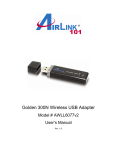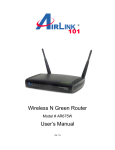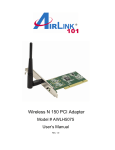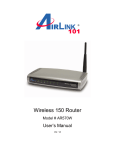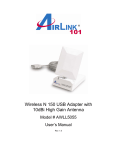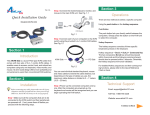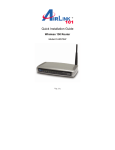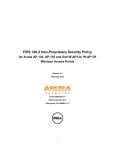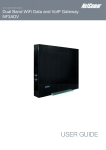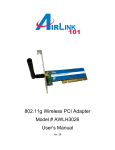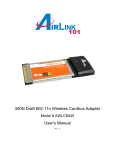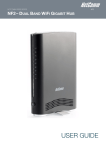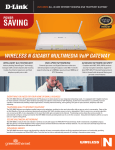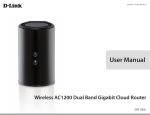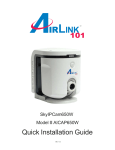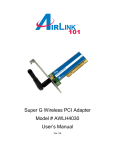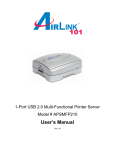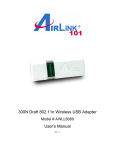Download User Manual - Airlink101
Transcript
Wireless AC1200 USB High Gain Adapter Model # AWLL7086HG User’s Manual Rev. 1.0 Table of Contents 1. Introduction ..............................................................................................................................2 1.1 Package Contents................................................................................................................2 1.2 Features...............................................................................................................................2 2. Install the Wireless Adapter .....................................................................................................3 3. Install the Driver/Utility on Mac OSX .....................................................................................7 4. Connect to the Wireless Network ...........................................................................................10 5. Configure Wireless Monitor...................................................................................................15 5.1 General..............................................................................................................................15 5.2 Profile Settings .................................................................................................................16 5.3 Available Network............................................................................................................18 5.4 Status ................................................................................................................................19 5.6 Configuring Wireless Security .........................................................................................25 5.7 Ad-hoc and Peer-to-Peer Wireless Networks ...................................................................30 5.8 About ................................................................................................................................32 Appendix A - Specification ........................................................................................................33 Technical Support.......................................................................................................................34 1 1. Introduction Congratulations on your purchase of the Wireless AC1200 USB High Gain Adapter. The compact design gives you more flexibility and its high bandwidth combined with extended wireless coverage delivers fast and reliable connection for all of your networking applications. The adapter will yield a higher throughput is it is used with other Airlink101® Wireless N products. A full range of security features such as WEP, WPA-PSK, and WPA2-PSK will provide you the highest level of wireless network security. The bundled wireless utility allows you to set up the adapter with an easy-to-use user interface. The Wireless AC1200 USB High Gain Adapter works with 802.11ac, 802.11n and 802.11g/b network devices ensuring compatibility with your existing wireless products. 1.1 Package Contents Before you begin the installation, please check the items of your package. The package should include the following items: • Wireless AC1200 USB High Gain Adapter • • • Extendable Base Station Quick Installation Guide Installation CD (Driver/Utility/Manual) 1.2 Features • • • • • • Higher data rate and broader coverage with Wireless AC 1200 technology WPA2, WPA, and WEP enhanced security to provide full protection for your wireless connection Great for environments that need higher wireless data traffic Fully backward compatible with 802.11n/b/g Light-weight, compact design RoHS compliant 2 2. Install the Wireless Adapter This section provides instructions on how to install the Wireless AC1200 USB High Gain Adapter. Step 2.1 Insert the USB adapter into an available USB slot on your computer. Step 2.2 Click Cancel if you see the Found New Hardware Wizard. Windows Vista Users: Windows XP Users: 3 Step 2.3 Insert the Installation CD in the CD drive. Note: If the Autorun screen doesn’t appear automatically, go to My Computer, double click your CD ROM drive. Step 2.4 The Autorun screen will pop up. Select Install Utility and Driver from the menu. Windows 7 / Vista Users: When you get a warning message make sure you click Allow to give permission to continue with the installation of the driver software. Step 2.5 Click Next and follow the instructions on the window to finish installation. 4 Step 2.6 Give Permission to Window to install the driver software. Windows 7 / Vista Users: Click the Install this driver software anyway. Windows XP Users: Click Continue Anyway at the Windows Logo Screen. 5 You will see the following message when it is installing the driver for Airlink101 Wireless Adapter and the Airlink101 Wireless Monitor. Step 2.7 Select Yes, I want to restart my computer now. Click Finish to complete the installation. 6 The driver and utility have been installed successfully. Please continue to the next chapter. 3. Install the Driver/Utility on Mac OSX This section provides instructions on how to install the Wireless N Ultra Mini USB Adapter on the OSX platform. The AWLL7086HG supports OSX 10.4 through 10.10. Step 3.1 Insert the USB adapter into an available USB slot on your computer. Step 3.2 Locate and open the .pkg file in the MAC folder. Step 3.3 Continue through the menu till you reach the License section. 7 Step 3.3 Choose you preferred language and press Continue to view the License Agreement. After review, press Agree to continue. 8 Step 3.4 Select Install or choose your install destination through Customize. Step 3.3 Press Continue to begin installation. 9 Step 3.3 After installation is complete, Restart your computer to begin using the Wireless Utility. 4. Connect to the Wireless Network This section describes how to connect your wireless adapter to a wireless network. For Windows 7 Users: You can use the utility built in Windows 7 or Airlink101 Wireless Monitor to manage this wireless USB adapter. 10 Step 4.1 Click on the wireless icon in the system tray at the bottom right-hand corner of your screen. A list of available network will pop up. Select the one you want to connect to and click Connect. Step 4.2 Enter the network security key if the wireless network you are attempting to connect to has wireless encryption enabled. Click OK. The connection should be now established. 11 For All Windows Users: Step 4.1 After rebooting the computer, open Airlink101 Wireless Monitor utility by double clicking on the Airlink101 Wireless Monitor Utility icon on your desktop. Step 4.2 Click the Available Network tab of the Wireless Monitor, select the SSID (Network Name) of the wireless network that you wish to connect to, and click Add to Profile. 12 Step 4.3 Enter the wireless security key into the Network Key box if the network you are attempting to connect has wireless security enabled. Click OK. Step 4.4 The connection should be now established. Verify that IP Address, Subnet Mask and Gateway have valid numbers assigned to them (instead of all 0’s). The Status should be Associated, and there will be green bars next to Signal Strength and Link Quality. 13 Congratulations! You have now connected to the wireless network successfully. Troubleshooting 1. If you cannot open the wireless monitor utility, make sure that the USB adapter is inserted firmly into the USB port. 2. If you cannot connect to the wireless router, you may want to double check the wireless security settings on the router. The network key you entered in Step 3.3 must match with the settings on the wireless router. 3. If you are experiencing problems with the connection such as low signal strength, slow connection speed, or unstable wireless connection, you can try to tune your router’s signal by changing the channels on the router and/or by adjusting the direction of the antenna(s). You do not need to change the channel on the Adapter; it will automatically pick up the new channel after you reboot the router. Your router has 11 different channels to choose from. Keep going through the channels until you find one that gives you a stable connection. For instructions on changing channels, refer to the documentation that comes with the router. 14 5. Configure Wireless Monitor This section describes the various functions of the Airlink101 Wireless Monitor that you can configure, including the settings of wireless encryption. 5.1 General The General tab provides you with the status of the current connection, including signal, network name (SSID) and IP Address. At the bottom you have options for controlling the utility and adapter. Show Tray Icon allows you to show or hide the tray icon for the utility. Radio Off disables the wireless function of the adapter. Disable Adapter will completely disable the wireless adapter. 15 Note: Virtual WiFi allowed is not supported in this utility version. 5.2 Profile Settings The Profile tab lists the current profiles and allows you to create new profiles. The Available Profile(s) box lists all the profiles that you’ve created for your wireless networks. Profiles are automatically created and added to this list when you connect to new networks. You can also manually add the profiles. To create a new profile, click on Add. The Profile box will appear allowing you to specify the settings for your new profile or to change settings for your existing profile. 16 Enter a Profile Name and SSID. Enter the encryption settings for the profile. Click OK to save the changes. To remove an existing profile, select the profile from the Available Profile(s) box and click on Remove. To modify an existing profile, select the profile from the Available Profile(s) box and click on Edit. To duplicate an existing profile, select the profile from the Available Profile(s) box and click on Duplicate. To activate an existing profile, select the profile from the Available Profile(s) box and click on Set Default. 17 5.3 Available Network The Available network tab lists all of the networks that the adapter detects in your area. Clicking Refresh will refresh the list. To connect to a network, select a network from the list and click Add to Profile. 18 5.4 Status The status section provides you with a list of information about the current status of the adapter. 19 5.5 Wi-Fi Protected Setup (WPS) The Wi-Fi Protected Setup™ (WPS) is a new and easy way to configure the encryption for your wireless network clients. In order to use it, you need to have a router that supports this feature, like the AR570W or AR675W Airlink101 Wireless N Router. You also need to configure the wireless encryption on the router; you should find the instructions for configuring it in the router’s User Manual. If your wireless router does not support WPS, then you need to set up the wireless security manually and you can skip this section. We are using the AR675W Airlink101 Wireless AC 1200 Green Router to illustrate the following setup instructions. Step 5.5.1 Open the Airlink101 Wireless Monitor. Click the Wi-Fi Protect Setup tab. Choose your configuration method: 20 - For Push Button method, click Push Button Config (PBC) tab, continue to Step 5.6.2a - For Pin Input Config method, click Pin Input Config (PIN) tab., continue to Step 5.6.3a Step 5.5.2a If you choose the Push Button method; click the Push Button Config (PBC) tab. Step 5.5.2b Push the Easy Setup Button (WPS button) on the router, and it will start the handshake with wireless adapter. The connection will be built up in couple minutes. Step 5.5.3a If you choose the Pin Code method, write down the PIN and click Yes. 21 Select the Access Point that you want to connect, and then click Select. 22 Step 5.5.3b Log on to your router’s configuration page from the web browser and click on Wireless. Then enter the WPS settings. Step 5.5.3c Make sure that the WPS is Enabled. In the Setup section, select Configure Wireless Station. Select Enrollee PIN and enter the PIN number assigned in step 5.6.3a. Press Trigger to begin the connection, save your settings when completed. 23 After a few moments both the router configuration screen and the adapter configuration screen should show a message telling you that a connection is established. Note: If you cannot connect successfully with WPS, you need to log in to your router’s configuration and click on Wireless. Then click Wireless security. Make sure that the Disable WPS box is NOT checked, refer to Step 5.6.3b. 24 5.6 Configuring Wireless Security This section describes the different types of encryption available and how to configure them. In most cases, encryption type will be automatically configured and all you need is to enter the Network key, as described in Section 3, Step 3.3. If you are creating a custom profile, you need to manually configure the encryption settings. Open the Wireless Monitor utility, click Profile tab and then click Add. The different options of wireless network encryption settings are: Disable: No encryption in use WEP: The most popular but least secure form of encryption 25 WPA/WPA2-PSK: The most secure and recommended level of encryption 26 5.6.1 Configuring WEP encryption Select WEP from the Data encryption box. Under Network Authentication, you will want to select Shared key or Open System, depending on the router settings. Select the encryption setting according to the setting of the router. • ASCII or PASSPHRASE will also be predetermined by the router. Refer to your routers settings to find out what you should select here. or • Key Index is the key on the router that is currently in use. Input the Network key that matches the Network key of the router. Click OK to save your settings. 27 5.6.2 Configuring WPA/WPA2-PSK Encryption (for home users) Select WPA-PSK/WPA2-PSK from the Network Authentication box. Under Data encryption select either AES or TKIP depending on the settings for your router. Enter the encryption key that the router is using into the Network Key box. Click OK to save your settings. 28 5.6.3 Configuring WPA/WPA2 Encryption (for corporate networks) Select WPA 802.1x / WPA2 802.1x from the Network Authentication box. Under Data encryption select either TKIP or AES depending on the settings for the router. 29 5.7 Ad-hoc and Peer-to-Peer Wireless Networks Ad-hoc networking is used when you want to connect two or more computers together but you don’t have a router. In ad-hoc mode, you lose many features that come with a router. The maximum connection speed drops to 11Mbps. In addition, WEP encryption is the only security available in ad-hoc mode. To set up ad-hoc mode, you will need to create a new profile. Open the Wireless Monitor. Click on Profile and click on Add. The profile settings box will appear. First change the network type to Adhoc, by checking the computer-to-computer (ad-hoc) network. Enter a network name (SSID) into the SSID box. Select your desired Channel. 30 You can also choose between no security or WEP security. If you choose WEP security, you can follow the instructions in the Configuring Encryption section of the manual. Click OK to save the profile. Select your new profile from the Available Profile(s) box, and double click to enable it. You need to configure all other computers that you are planning on connecting to your ad-hoc network with the same settings that you input on this screen. Every computer has to be set up exactly the same. If any of the settings are different, the network will not function. Troubleshooting: If you are having trouble connecting, slow connection, or connection is unstable, you will want to try changing channels. Start with channel 1 and work your way up until you find a channel that gives you the best connection. Each time you change the channel, save the settings then reboot the computer. Also, 31 make sure that you do this on every ad-hoc machine so that they will all be set to the same channel. 5.8 About The About window provides the information about the Wireless Monitor Utility version and the current driver version. 32 Appendix A - Specification Frequency Band • 2.4Ghz Standards • IEEE 802.11b / g / n Interface • USB 3.0 / 2.0 / 1.1 Data Rate* • 2.4GHz: 300Mbps • 5GHz: 900Mbps Antenna Type • 2 Detachable 5dBi antennas Security • WPA2/WPA-PSK (TKIP & AES) • WEP 64/128-bit • 802.1x LED • Link/Power System Requirements • Windows 8, 7, Vista and XP • Mac OS 10.4 - 10.10 • Available USB slot Weight • 25g Dimensions • 92.5 x 27 x 15mm (L x W x H) Temperature • Operating: 0ºC to 40ºC (32ºF~104ºF) • Storage: -40ºC to 70ºC (-40ºF~158ºF) Humidity • Operating: 10% to 90% NonCondensing • Storage: 5% to 90% Non-Condensing Warranty • Limited 1-year warranty Safety Approvals • FCC, CE 33 Technical Support E-mail: [email protected] Toll Free: 1-888-746-3238 Web Site: www.airlink101.com *Theoretical maximum wireless signal rate derived from IEEE standard 802.11 specifications. Actual data throughput will vary. Network conditions and environmental factors, including volume of network traffic, building materials and construction, mix of wireless products used, radio frequency interference (e.g., cordless telephones and microwaves) as well as network overhead lower actual data throughput rate. Compatibility with 802.11ac devices from other manufactures is not guaranteed. Specifications are subject to change without notice. Photo of product may not reflect actual content. All products and trademarks are the property of their respective owners. Copyright ©2015 Airlink101® 34



































